flat tire TOYOTA AYGO 2019 Owners Manual (in English)
[x] Cancel search | Manufacturer: TOYOTA, Model Year: 2019, Model line: AYGO, Model: TOYOTA AYGO 2019Pages: 504, PDF Size: 67.32 MB
Page 4 of 504
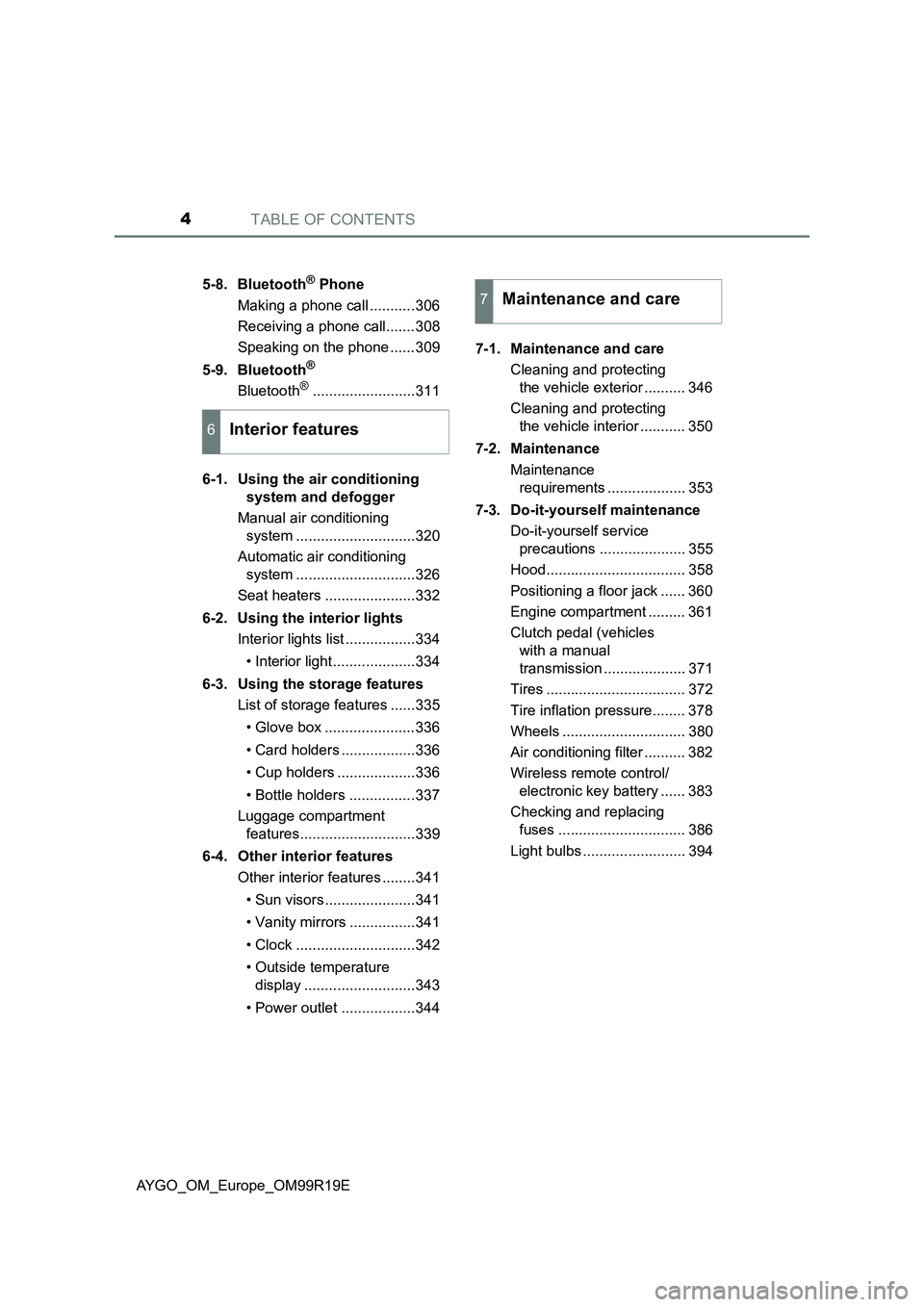
TABLE OF CONTENTS4
AYGO_OM_Europe_OM99R19E
5-8. Bluetooth® Phone
Making a phone call ...........306
Receiving a phone call.......308
Speaking on the phone ......309
5-9. Bluetooth®
Bluetooth®.........................311
6-1. Using the air conditioning
system and defogger
Manual air conditioning
system .............................320
Automatic air conditioning
system .............................326
Seat heaters ......................332
6-2. Using the interior lights
Interior lights list .................334
• Interior light ....................334
6-3. Using the storage features
List of storage features ......335
• Glove box ......................336
• Card holders ..................336
• Cup holders ...................336
• Bottle holders ................337
Luggage compartment
features............................339
6-4. Other interior features
Other interior features ........341
• Sun visors ......................341
• Vanity mirrors ................341
• Clock .............................342
• Outside temperature
display ...........................343
• Power outlet ..................344
7-1. Maintenance and care
Cleaning and protecting
the vehicle exterior .......... 346
Cleaning and protecting
the vehicle interior ........... 350
7-2. Maintenance
Maintenance
requirements ................... 353
7-3. Do-it-yourself maintenance
Do-it-yourself service
precautions ..................... 355
Hood.................................. 358
Positioning a floor jack ...... 360
Engine compartment ......... 361
Clutch pedal (vehicles
with a manual
transmission .................... 371
Tires .................................. 372
Tire inflation pressure........ 378
Wheels .............................. 380
Air conditioning filter .......... 382
Wireless remote control/
electronic key battery ...... 383
Checking and replacing
fuses ............................... 386
Light bulbs ......................... 394
6Interior features
7Maintenance and care
Page 5 of 504
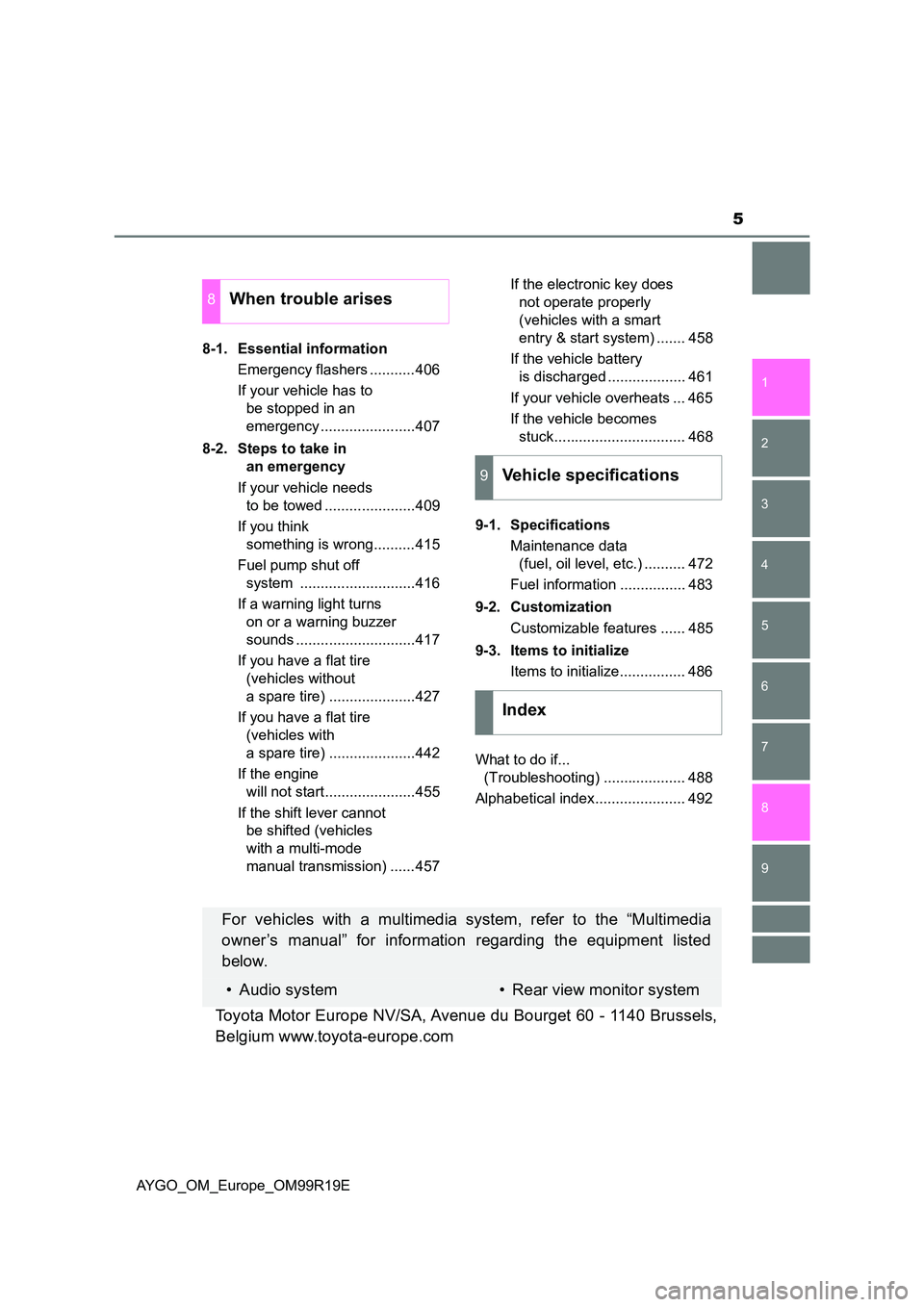
5
1
7
8
6
5
4
3
2
9
AYGO_OM_Europe_OM99R19E
8-1. Essential information
Emergency flashers ...........406
If your vehicle has to
be stopped in an
emergency .......................407
8-2. Steps to take in
an emergency
If your vehicle needs
to be towed ......................409
If you think
something is wrong..........415
Fuel pump shut off
system ............................416
If a warning light turns
on or a warning buzzer
sounds .............................417
If you have a flat tire
(vehicles without
a spare tire) .....................427
If you have a flat tire
(vehicles with
a spare tire) .....................442
If the engine
will not start......................455
If the shift lever cannot
be shifted (vehicles
with a multi-mode
manual transmission) ......457
If the electronic key does
not operate properly
(vehicles with a smart
entry & start system) ....... 458
If the vehicle battery
is discharged ................... 461
If your vehicle overheats ... 465
If the vehicle becomes
stuck................................ 468
9-1. Specifications
Maintenance data
(fuel, oil level, etc.) .......... 472
Fuel information ................ 483
9-2. Customization
Customizable features ...... 485
9-3. Items to initialize
Items to initialize................ 486
What to do if...
(Troubleshooting) .................... 488
Alphabetical index...................... 492
8When trouble arises
9Vehicle specifications
Index
For vehicles with a multimedia system, refer to the “Multimedia
owner’s manual” for information regarding the equipment listed
below.
• Audio system• Rear view monitor system
Toyota Motor Europe NV/SA, Avenue du Bourget 60 - 1140 Brussels,
Belgium www.toyota-europe.com
Page 11 of 504
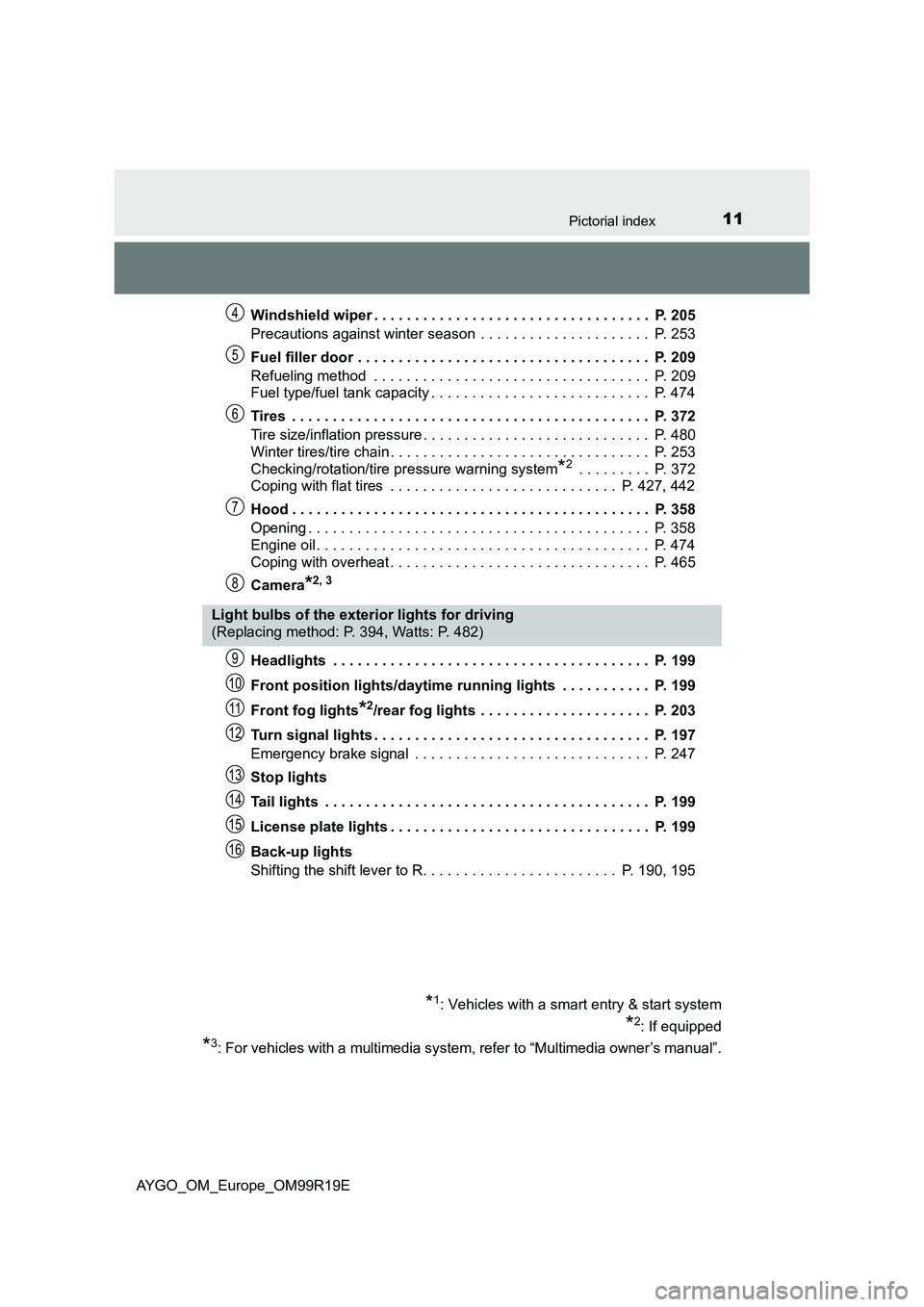
11Pictorial index
AYGO_OM_Europe_OM99R19EWindshield wiper . . . . . . . . . . . . . . . . . . . . . . . . . . . . . . . . . . P. 205
Precautions against winter season . . . . . . . . . . . . . . . . . . . . . P. 253
Fuel filler door . . . . . . . . . . . . . . . . . . . . . . . . . . . . . . . . . . . . P. 209
Refueling method . . . . . . . . . . . . . . . . . . . . . . . . . . . . . . . . . . P. 209
Fuel type/fuel tank capacity . . . . . . . . . . . . . . . . . . . . . . . . . . . P. 474
Tires . . . . . . . . . . . . . . . . . . . . . . . . . . . . . . . . . . . . . . . . . . . . P. 372
Tire size/inflation pressure . . . . . . . . . . . . . . . . . . . . . . . . . . . . P. 480
Winter tires/tire chain . . . . . . . . . . . . . . . . . . . . . . . . . . . . . . . . P. 253
Checking/rotation/tire pressure warning system
*2 . . . . . . . . . P. 372
Coping with flat tires . . . . . . . . . . . . . . . . . . . . . . . . . . . . P. 427, 442
Hood . . . . . . . . . . . . . . . . . . . . . . . . . . . . . . . . . . . . . . . . . . . . P. 358
Opening . . . . . . . . . . . . . . . . . . . . . . . . . . . . . . . . . . . . . . . . . . P. 358
Engine oil . . . . . . . . . . . . . . . . . . . . . . . . . . . . . . . . . . . . . . . . . P. 474
Coping with overheat . . . . . . . . . . . . . . . . . . . . . . . . . . . . . . . . P. 465
Camera
*2, 3
Headlights . . . . . . . . . . . . . . . . . . . . . . . . . . . . . . . . . . . . . . . P. 199
Front position lights/daytime running lights . . . . . . . . . . . P. 199
Front fog lights
*2/rear fog lights . . . . . . . . . . . . . . . . . . . . . P. 203
Turn signal lights . . . . . . . . . . . . . . . . . . . . . . . . . . . . . . . . . . P. 197
Emergency brake signal . . . . . . . . . . . . . . . . . . . . . . . . . . . . . P. 247
Stop lights
Tail lights . . . . . . . . . . . . . . . . . . . . . . . . . . . . . . . . . . . . . . . . P. 199
License plate lights . . . . . . . . . . . . . . . . . . . . . . . . . . . . . . . . P. 199
Back-up lights
Shifting the shift lever to R. . . . . . . . . . . . . . . . . . . . . . . . P. 190, 195
4
5
6
7
8
Light bulbs of the exterior lights for driving
(Replacing method: P. 394, Watts: P. 482)
*1: Vehicles with a smart entry & start system
*2: If equipped
*3: For vehicles with a multimedia system , refer to “Multimedia owner’s manual”.
9
10
11
12
13
14
15
16
Page 178 of 504
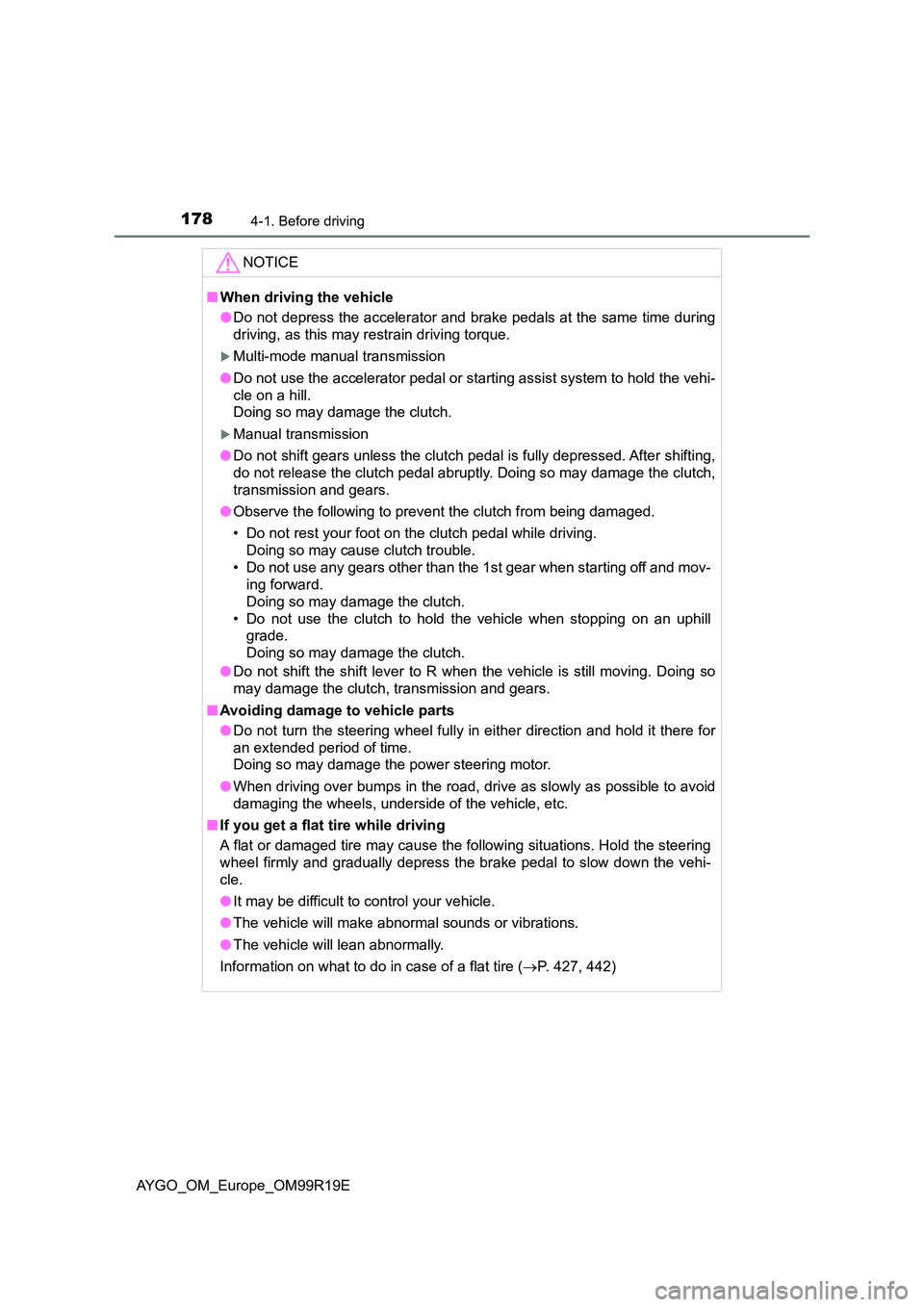
1784-1. Before driving
AYGO_OM_Europe_OM99R19E
NOTICE
■When driving the vehicle
●Do not depress the accelerator and brake pedals at the same time during
driving, as this may restrain driving torque.
Multi-mode manual transmission
● Do not use the accelerator pedal or starting assist system to hold the vehi-
cle on a hill.
Doing so may damage the clutch.
Manual transmission
● Do not shift gears unless the clutch pedal is fully depressed. After shifting,
do not release the clutch pedal abruptly. Doing so may damage the clutch,
transmission and gears.
● Observe the following to prevent the clutch from being damaged.
• Do not rest your foot on the clutch pedal while driving.
Doing so may cause clutch trouble.
• Do not use any gears other than the 1st gear when starting off and mov- ing forward.
Doing so may damage the clutch.
• Do not use the clutch to hold the vehicle when stopping on an uphill grade.
Doing so may damage the clutch.
● Do not shift the shift lever to R when the vehicle is still moving. Doing so
may damage the clutch, transmission and gears.
■ Avoiding damage to vehicle parts
●Do not turn the steering wheel fully in either direction and hold it there for
an extended period of time.
Doing so may damage the power steering motor.
● When driving over bumps in the road, drive as slowly as possible to avoid
damaging the wheels, underside of the vehicle, etc.
■ If you get a flat tire while driving
A flat or damaged tire may cause the following situations. Hold the steering
wheel firmly and gradually depress the brake pedal to slow down the vehi-
cle.
●It may be difficult to control your vehicle.
● The vehicle will make abnormal sounds or vibrations.
● The vehicle will lean abnormally.
Information on what to do in case of a flat tire ( P. 427, 442)
Page 230 of 504
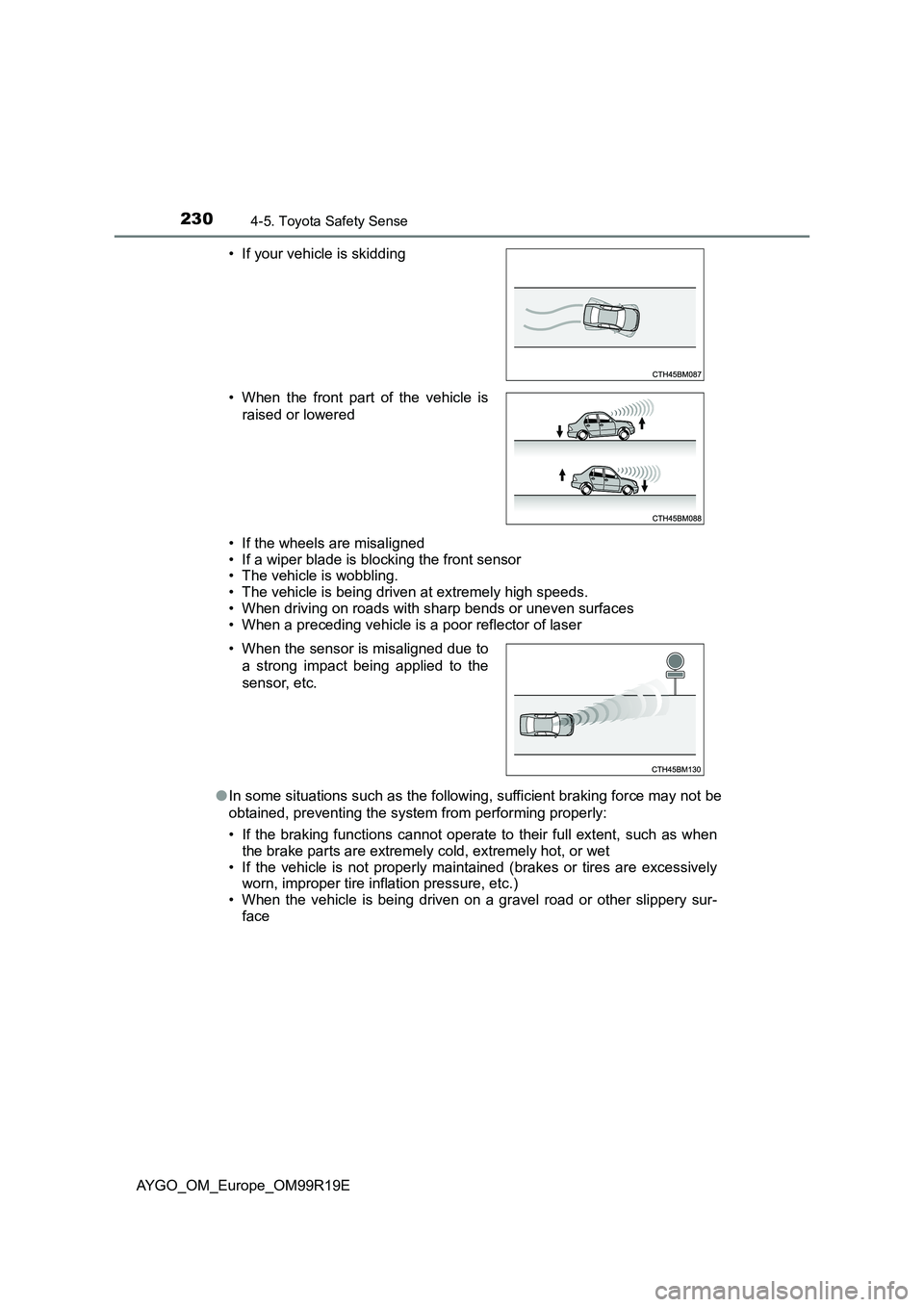
2304-5. Toyota Safety Sense
AYGO_OM_Europe_OM99R19E
• If the wheels are misaligned
• If a wiper blade is blocking the front sensor
• The vehicle is wobbling.
• The vehicle is being driven at extremely high speeds.
• When driving on roads with sharp bends or uneven surfaces
• When a preceding vehicle is a poor reflector of laser
● In some situations such as the following, sufficient braking force may not be
obtained, preventing the system from performing properly:
• If the braking functions cannot operate to their full extent, such as when
the brake parts are extremely cold, extremely hot, or wet
• If the vehicle is not properly maintained (brakes or tires are excessively
worn, improper tire inflation pressure, etc.)
• When the vehicle is being driven on a gravel road or other slippery sur-
face
• If your vehicle is skidding
• When the front part of the vehicle is
raised or lowered
• When the sensor is misaligned due to
a strong impact being applied to the
sensor, etc.
Page 235 of 504
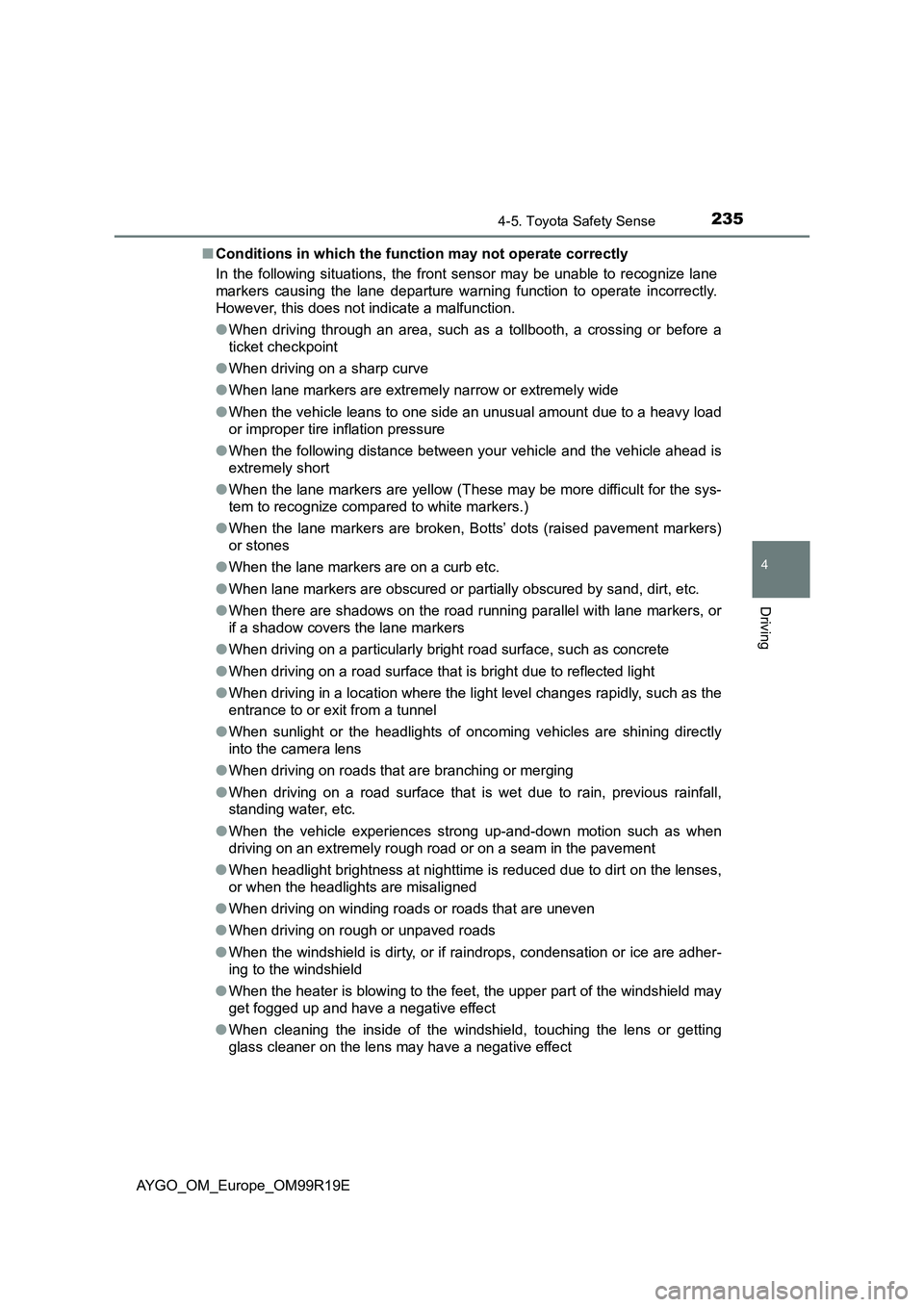
2354-5. Toyota Safety Sense
4
Driving
AYGO_OM_Europe_OM99R19E
■ Conditions in which the function may not operate correctly
In the following situations, the front sensor may be unable to recognize lane
markers causing the lane departure warning function to operate incorrectly.
However, this does not indicate a malfunction.
● When driving through an area, such as a tollbooth, a crossing or before a
ticket checkpoint
● When driving on a sharp curve
● When lane markers are extremely narrow or extremely wide
● When the vehicle leans to one side an unusual amount due to a heavy load
or improper tire inflation pressure
● When the following distance between your vehicle and the vehicle ahead is
extremely short
● When the lane markers are yellow (These may be more difficult for the sys-
tem to recognize compared to white markers.)
● When the lane markers are broken, Botts’ dots (raised pavement markers)
or stones
● When the lane markers are on a curb etc.
● When lane markers are obscured or partially obscured by sand, dirt, etc.
● When there are shadows on the road running parallel with lane markers, or
if a shadow covers the lane markers
● When driving on a particularly bright road surface, such as concrete
● When driving on a road surface that is bright due to reflected light
● When driving in a location where the light level changes rapidly, such as the
entrance to or exit from a tunnel
● When sunlight or the headlights of oncoming vehicles are shining directly
into the camera lens
● When driving on roads that are branching or merging
● When driving on a road surface that is wet due to rain, previous rainfall,
standing water, etc.
● When the vehicle experiences strong up-and-down motion such as when
driving on an extremely rough road or on a seam in the pavement
● When headlight brightness at nighttime is reduced due to dirt on the lenses,
or when the headlights are misaligned
● When driving on winding roads or roads that are uneven
● When driving on rough or unpaved roads
● When the windshield is dirty, or if raindrops, condensation or ice are adher-
ing to the windshield
● When the heater is blowing to the feet, the upper part of the windshield may
get fogged up and have a negative effect
● When cleaning the inside of the windshield, touching the lens or getting
glass cleaner on the lens may have a negative effect
Page 252 of 504
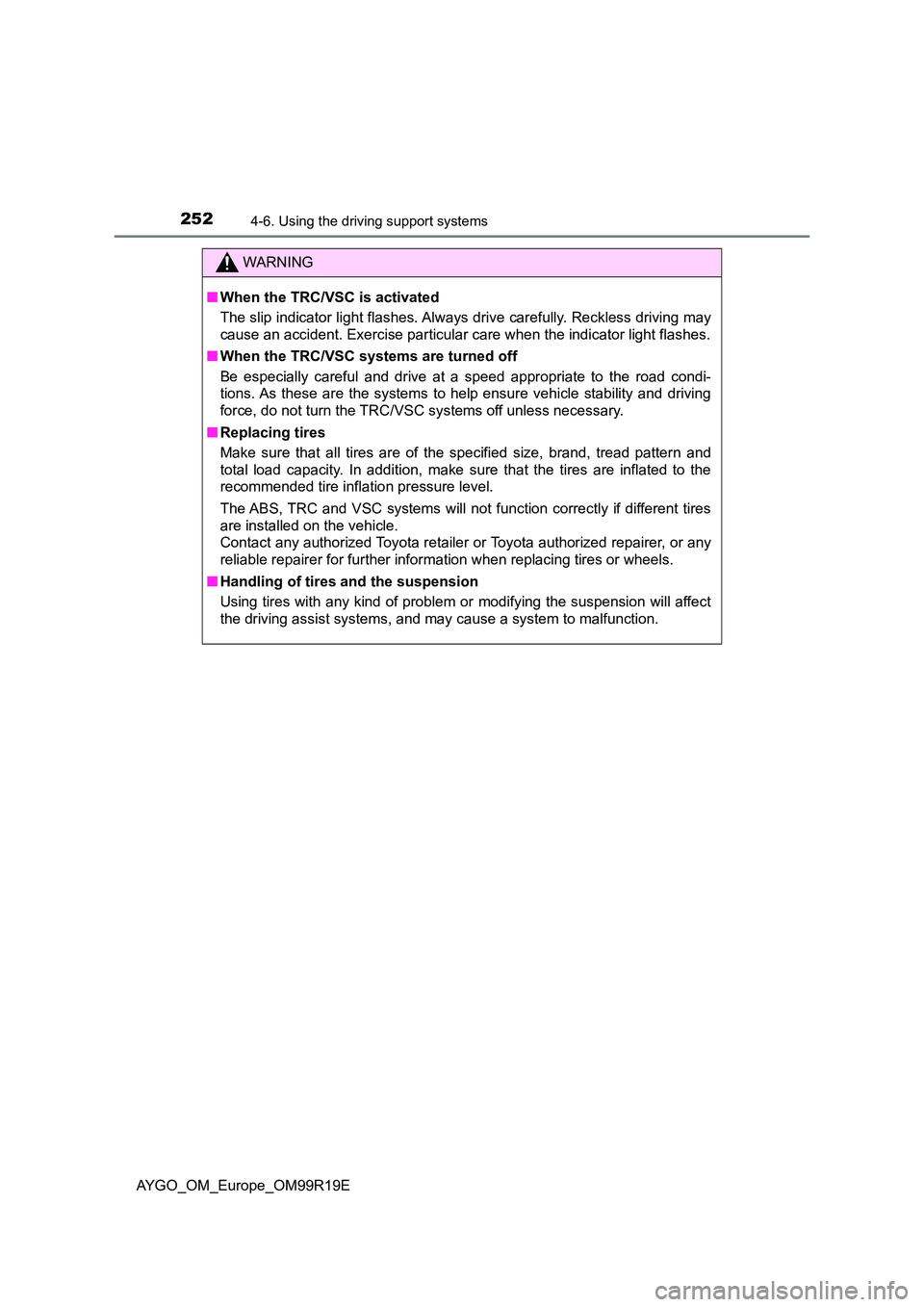
2524-6. Using the driving support systems
AYGO_OM_Europe_OM99R19E
WARNING
■When the TRC/VSC is activated
The slip indicator light flashes. Always drive carefully. Reckless driving may
cause an accident. Exercise particular care when the indicator light flashes.
■ When the TRC/VSC systems are turned off
Be especially careful and drive at a speed appropriate to the road condi-
tions. As these are the systems to help ensure vehicle stability and driving
force, do not turn the TRC/VSC systems off unless necessary.
■ Replacing tires
Make sure that all tires are of the specified size, brand, tread pattern and
total load capacity. In addition, make sure that the tires are inflated to the
recommended tire inflation pressure level.
The ABS, TRC and VSC systems will not function correctly if different tires
are installed on the vehicle.
Contact any authorized Toyota retailer or Toyota authorized repairer, or any
reliable repairer for further information when replacing tires or wheels.
■ Handling of tires and the suspension
Using tires with any kind of problem or modifying the suspension will affect
the driving assist systems, and may cause a system to malfunction.
Page 345 of 504
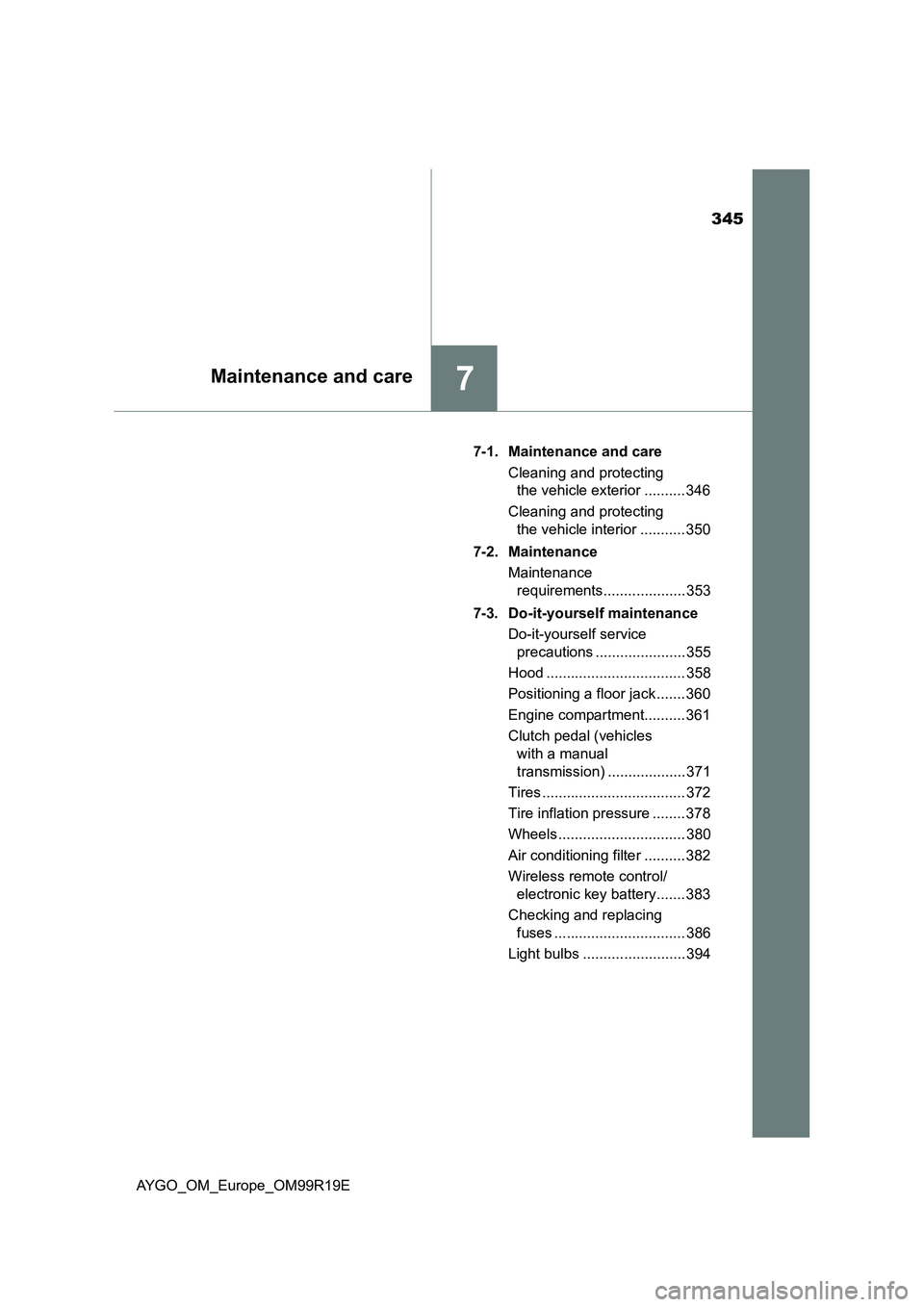
345
7Maintenance and care
AYGO_OM_Europe_OM99R19E
7-1. Maintenance and care
Cleaning and protecting
the vehicle exterior .......... 346
Cleaning and protecting
the vehicle interior ........... 350
7-2. Maintenance
Maintenance
requirements.................... 353
7-3. Do-it-yourself maintenance
Do-it-yourself service
precautions ...................... 355
Hood .................................. 358
Positioning a floor jack ....... 360
Engine compartment.......... 361
Clutch pedal (vehicles
with a manual
transmission) ................... 371
Tires ................................... 372
Tire inflation pressure ........ 378
Wheels ............................... 380
Air conditioning filter .......... 382
Wireless remote control/
electronic key battery....... 383
Checking and replacing
fuses ................................ 386
Light bulbs ......................... 394
Page 354 of 504
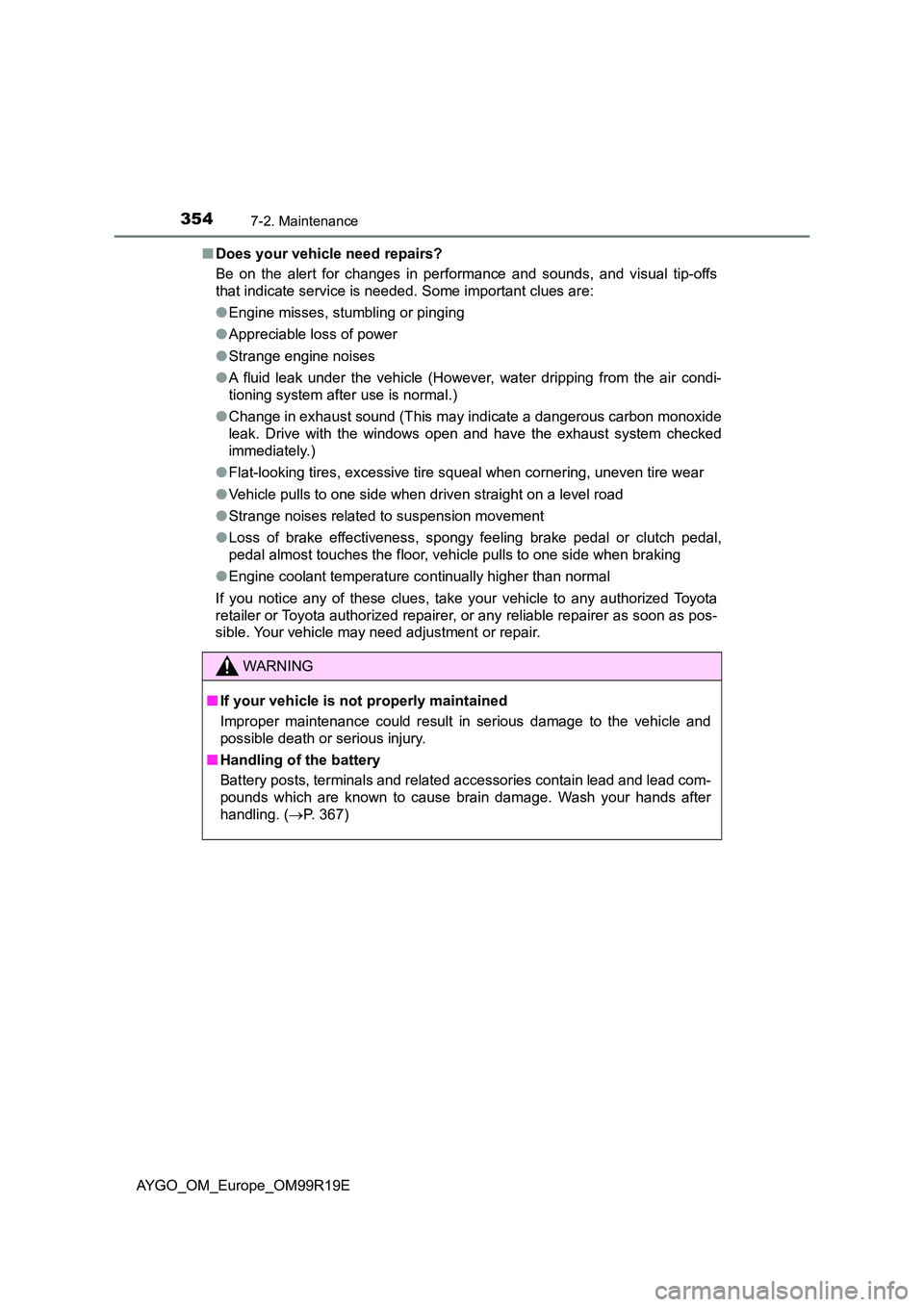
3547-2. Maintenance
AYGO_OM_Europe_OM99R19E
■ Does your vehicle need repairs?
Be on the alert for changes in performance and sounds, and visual tip-offs
that indicate service is needed. Some important clues are:
● Engine misses, stumbling or pinging
● Appreciable loss of power
● Strange engine noises
● A fluid leak under the vehicle (However, water dripping from the air condi-
tioning system after use is normal.)
● Change in exhaust sound (This may indicate a dangerous carbon monoxide
leak. Drive with the windows open and have the exhaust system checked
immediately.)
● Flat-looking tires, excessive tire squeal when cornering, uneven tire wear
● Vehicle pulls to one side when driven straight on a level road
● Strange noises related to suspension movement
● Loss of brake effectiveness, spongy feeling brake pedal or clutch pedal,
pedal almost touches the floor, vehicle pulls to one side when braking
● Engine coolant temperature continually higher than normal
If you notice any of these clues, take your vehicle to any authorized Toyota
retailer or Toyota authorized repairer, or any reliable repairer as soon as pos-
sible. Your vehicle may need adjustment or repair.
WARNING
■ If your vehicle is not properly maintained
Improper maintenance could result in serious damage to the vehicle and
possible death or serious injury.
■ Handling of the battery
Battery posts, terminals and related accessories contain lead and lead com-
pounds which are known to cause brain damage. Wash your hands after
handling. ( P. 367)
Page 355 of 504
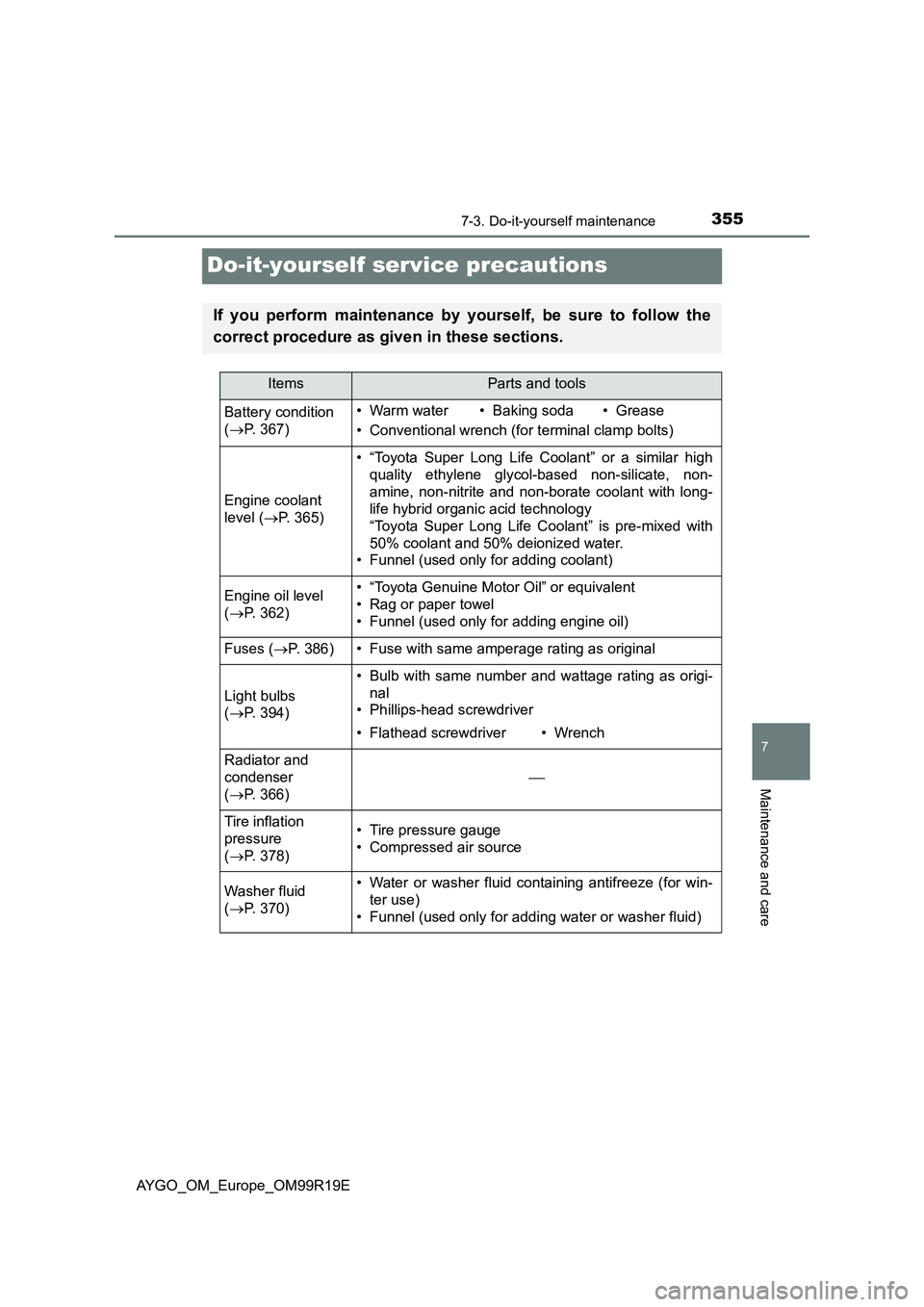
3557-3. Do-it-yourself maintenance
7
Maintenance and care
AYGO_OM_Europe_OM99R19E
Do-it-yourself service precautions
If you perform maintenance by yourself, be sure to follow the
correct procedure as given in these sections.
ItemsParts and tools
Battery condition
( P. 367)
•Warm water• Baking soda•Grease
• Conventional wrench (for terminal clamp bolts)
Engine coolant
level ( P. 365)
• “Toyota Super Long Life Coolant” or a similar high
quality ethylene glycol-based non-silicate, non-
amine, non-nitrite and non-borate coolant with long-
life hybrid organic acid technology
“Toyota Super Long Life Coolant” is pre-mixed with
50% coolant and 50% deionized water.
• Funnel (used only for adding coolant)
Engine oil level
( P. 362)
• “Toyota Genuine Motor Oil” or equivalent
• Rag or paper towel
• Funnel (used only for adding engine oil)
Fuses ( P. 3 8 6 )• Fuse with same amperage rating as original
Light bulbs
( P. 394)
• Bulb with same number and wattage rating as origi-
nal
• Phillips-head screwdriver
• Flathead screwdriver•Wrench
Radiator and
condenser
( P. 366)
Tire inflation
pressure
( P. 378)
• Tire pressure gauge
• Compressed air source
Washer fluid
( P. 370)
• Water or washer fluid containing antifreeze (for win-
ter use)
• Funnel (used only for adding water or washer fluid)